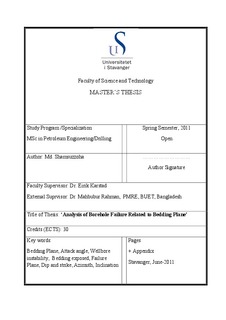| dc.description.abstract | Borehole instabilities during drilling are more common in shale formations than in most other rock formations. Shale make up more than 80% of sediments and rocks in siliciclastic environments and about three quarters of borehole problems are caused by shale instability.
The assessment of in-situ stress and analysis of borehole failure due to instability and weak bedding plane represents one of the most critical factors when evaluating borehole stability that causes borehole failure. Significant amount of research have been done in this area which resulted in various mathematical models about the issue of borehole failure, stability and plane of weakness due to bedding. Especially Aadnoy, Chenevert , Jaeger and Zoback showed that at a certain angle rock failed at a very low load condition. Several material constitutive models have been considered for rock failure studies, including the Mohr-Coulomb, the Mogi-Coulomb, the Mohr-Coulomb elasto-plastic, Dracker-Prager, and the modified Lade models by all researchers. Shale instability is an extremely unpredictable and potentially costly problem in many foothill drilling operations still now. So far, unified decision about the plane of weakness and failure of borehole on shale is yet to be fully realized by the industry.
This paper analyzed the bedding plane failure and reproduced some of the results published in literature. This works studied based on the Aadnoy et.al. (2009) paper’s field data and reproduced their combination of parameters that create bedding exposed positions. This thesis paper is based on a linear elastic and isotropic model for stresses around the wellbore, with the aim of trying to understand the general behavior of inclined boreholes due to anisotropy. It was found that borehole collapse was caused predominantly mainly by shear but also by tensile failure. The analysis remarkably found that for a laminated rock, a weakness of a plane may subject the well toward collapse for the hole angles between 10 to 400 (Aadnoy and Chenevert 1987).
This paper analyzed the 3D effect of attack angle with changing azimuth for a constant inclination on bedding plane. It is seen that bedding exposed is not only depends on inclination but also depends on dip of the formation, attack angle and azimuth. This paper also made a model which is enhanced Aadnoy et.al. (2009) model so that users can get the optimized well path and can make sure whether their well data has existed on the bedding exposed or protected positions. This thesis has tried to focus on mechanical wellbore stability and plane of weakness of shale formation and analyzed the Aadnoy et.al (2009) models to address the existing problem on this matter. | no_NO |
